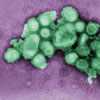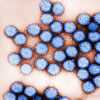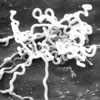Success Stories
CDC Mosquito Trap for Mosquito Surveillance and Control

CDC’s Autocidal Gravid Ovitrap (AGO) mosquito trap has been successfully used by mosquito control programs for mosquito surveillance and control. The patented AGO attracts and catches female Aedes aegypti mosquitoes looking for a place to lay eggs. Field trials in which the AGO trap has been installed in most homes in a community have shown it reduces mosquito populations AND rates of infection. Smaller scale field trials were so successful that CDC and the Puerto Rico Department of Health are implementing large-scale installation of AGO traps throughout several communities to help reduce mosquito populations and the viruses they spread.
A commercial partner is working to mass produce the trap and make it available on the commercial market.
CDC Photo, CDC NCEZID Puerto Rico laboratory.
Rapid Detection of Black Mold
 There is always some mold everywhere – in the air and on many surfaces. Mold has been on the Earth for millions of years. Molds grow where there is moisture and they can flourish in damp, warm, and humid environments. Some people are sensitive to molds and can be prone to infections or allergic reactions depending upon their immune status.
There is always some mold everywhere – in the air and on many surfaces. Mold has been on the Earth for millions of years. Molds grow where there is moisture and they can flourish in damp, warm, and humid environments. Some people are sensitive to molds and can be prone to infections or allergic reactions depending upon their immune status.
A Diagnostic Test to Detect Different Vaginal Yeast Infection Types

Vulvovaginal candidiasis, also known as a vaginal yeast infection, is a common condition of women worldwide, with over 70% of women experiencing an infection once in their lifetime. While most candidiasis patients are infected with Candida albicans, the number of non-C. albicans infections have grown steadily in recent years. Importantly, yeast infections caused by non-albicans species are resistant to azole drugs typically prescribed for C. albicans infections, resulting in reoccurrence of non-albicans infections.
In a video , CDC inventor Dr. Christine Morrison discusses Candida infection diagnostics and commercialization efforts which received a 2016 Federal Laboratory Consortium (FLC) Excellence in Technology Transfer award.
CDC’s Kevin Brand discusses the process of licensing the Candida infection diagnostic technology as part of the 2016 FLC Excellence in Technology Transfer award.
CDC’s Dr. Christine Morrison shares brief insights for inventors on the benefits of reporting new discoveries.
Identification of a Novel Influenza Strain that Causes Kennel Cough
 “Kennel cough” or infectious tracheobronchitis (ITB) is an acute, contagious respiratory infection in dogs characterized mainly by coughing. Canine ITB is considered one of the most prevalent infectious respiratory diseases in dogs worldwide. Outbreaks can reach epidemic proportions when dogs are housed in high-density population environments such as kennels. Canine ITB can be triggered by a variety of pathogens, including canine influenza virus.
“Kennel cough” or infectious tracheobronchitis (ITB) is an acute, contagious respiratory infection in dogs characterized mainly by coughing. Canine ITB is considered one of the most prevalent infectious respiratory diseases in dogs worldwide. Outbreaks can reach epidemic proportions when dogs are housed in high-density population environments such as kennels. Canine ITB can be triggered by a variety of pathogens, including canine influenza virus.
Tackling the H1N1 Flu Pandemic Through the Rapid Detection of the Novel H1N1 Virus
 H1N1 influenza emerged in the US in 2009. Within a year, it caused a worldwide pandemic that resulted in an estimated 60.8 million cases, 274,304 hospitalizations, and 12,469 deaths in the US alone. Global estimates of the 2009 H1N1 pandemic indicated that 151,700 – 575,400 people died, with the majority of deaths occurring in Africa and Southeast Asia.
H1N1 influenza emerged in the US in 2009. Within a year, it caused a worldwide pandemic that resulted in an estimated 60.8 million cases, 274,304 hospitalizations, and 12,469 deaths in the US alone. Global estimates of the 2009 H1N1 pandemic indicated that 151,700 – 575,400 people died, with the majority of deaths occurring in Africa and Southeast Asia.
Combatting the dangers of heavy metal contamination: the CDC can lead the way!
 Exposure to lead and other heavy metals remains a public health concern in environments where individuals can be exposed to such metals. Various venues present the danger of skin contamination, including the battlefield, outdoor hunting activities, and exposure from work in industrial settings. The cumulative effects of skin exposure to lead and other heavy metals can lead to organ and renal failure, and adversely impact blood pressure and brain activity.
Exposure to lead and other heavy metals remains a public health concern in environments where individuals can be exposed to such metals. Various venues present the danger of skin contamination, including the battlefield, outdoor hunting activities, and exposure from work in industrial settings. The cumulative effects of skin exposure to lead and other heavy metals can lead to organ and renal failure, and adversely impact blood pressure and brain activity.
Collaborative Efforts Yield Improved Rotavirus Vaccine
 Rotavirus is a common diarrhea-causing pathogen in children. Prior to rotavirus vaccination availability, rotavirus caused an average of 611,000 deaths per year globally and millions of hospitalizations. Virtually all children were infected by rotavirus by age 5. Rotavirus continues to cause severe diarrhea in infants and young children in the U.S. and globally. The majority of children that have access to adequate medical care survive infection with no significant long-term consequences. However, the number of deaths associated with severe diarrhea, vomiting, dehydration, and shock is staggering and preventive intervention is required.
Rotavirus is a common diarrhea-causing pathogen in children. Prior to rotavirus vaccination availability, rotavirus caused an average of 611,000 deaths per year globally and millions of hospitalizations. Virtually all children were infected by rotavirus by age 5. Rotavirus continues to cause severe diarrhea in infants and young children in the U.S. and globally. The majority of children that have access to adequate medical care survive infection with no significant long-term consequences. However, the number of deaths associated with severe diarrhea, vomiting, dehydration, and shock is staggering and preventive intervention is required.
Development of Syphilis Screen & Confirm Assay
 Syphilis is a sexually transmitted infection that remains a global health threat. The World Health Organization estimates that approximately 10.6 million new cases of syphilis infections are reported annually worldwide. Previously, the only commercially available serological test for syphilis determined lifetime exposure to Treponema pallidum, the bacterium that causes syphilis. This test was not able to distinguish between an active syphilis infection from lifetime exposure to the bacteria.
Syphilis is a sexually transmitted infection that remains a global health threat. The World Health Organization estimates that approximately 10.6 million new cases of syphilis infections are reported annually worldwide. Previously, the only commercially available serological test for syphilis determined lifetime exposure to Treponema pallidum, the bacterium that causes syphilis. This test was not able to distinguish between an active syphilis infection from lifetime exposure to the bacteria.
- Page last reviewed: June 29, 2017
- Page last updated: February 1, 2017
- Content source:
- Office of the Associate Director for Science


 ShareCompartir
ShareCompartir